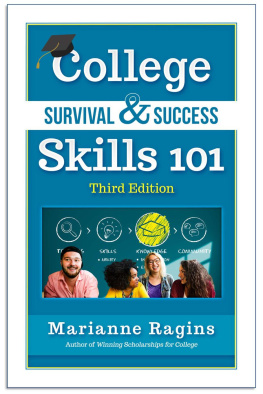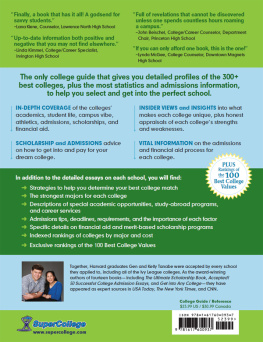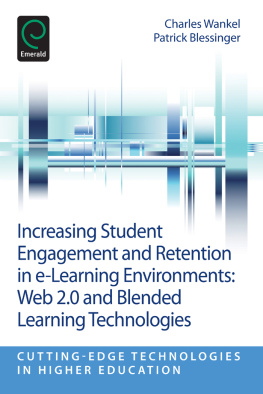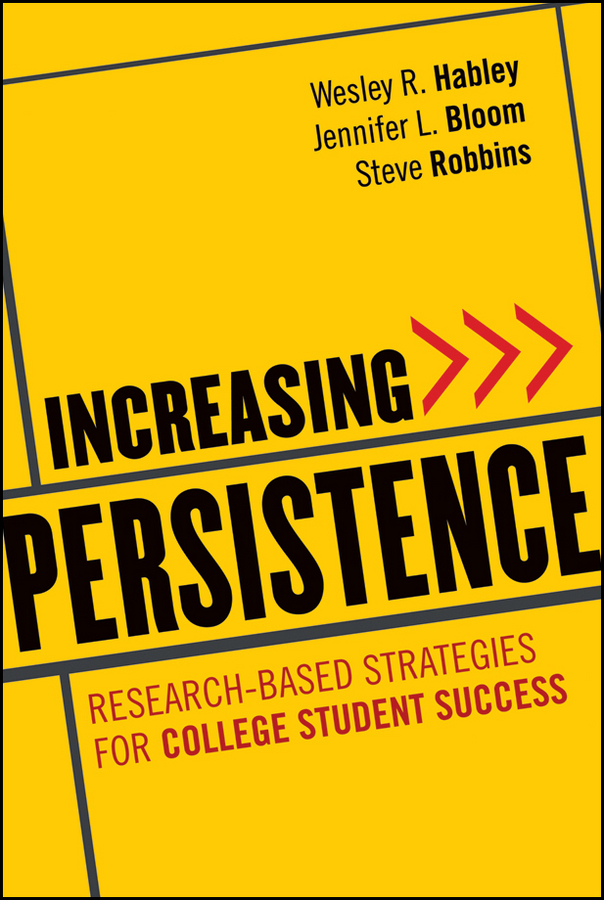Contents

Copyright 2012 by John Wiley & Sons, Inc. All rights reserved.
Published by Jossey-Bass
A Wiley Imprint
One Montgomery Street, Suite 1200, San Francisco, CA 94104-4594 www.josseybass.com
No part of this publication may be reproduced, stored in a retrieval system, or transmitted in any form or by any means, electronic, mechanical, photocopying, recording, scanning, or otherwise, except as permitted under Section 107 or 108 of the 1976 United States Copyright Act, without either the prior written permission of the publisher, or authorization through payment of the appropriate per-copy fee to the Copyright Clearance Center, Inc., 222 Rosewood Drive, Danvers, MA 01923, 978-750-8400, fax 978-646-8600, or on the Web at www.copyright.com . Requests to the publisher for permission should be addressed to the Permissions Department, John Wiley & Sons, Inc., 111 River Street, Hoboken, NJ 07030, 201-748-6011, fax 201-748-6008, or online at www.wiley.com/go/permissions .
Limit of Liability/Disclaimer of Warranty: While the publisher and author have used their best efforts in preparing this book, they make no representations or warranties with respect to the accuracy or completeness of the contents of this book and specifically disclaim any implied warranties of merchantability or fitness for a particular purpose. No warranty may be created or extended by sales representatives or written sales materials. The advice and strategies contained herein may not be suitable for your situation. You should consult with a professional where appropriate. Neither the publisher nor author shall be liable for any loss of profit or any other commercial damages, including but not limited to special, incidental, consequential, or other damages. Readers should be aware that Internet Web sites offered as citations and/or sources for further information may have changed or disappeared between the time this was written and when it is read.
Figures 8.1, 8.2, 8.3, 8.4, 9.1, 9.2, 9.3, 9.4, 9.5, 9.6, 10.1, 10.2, 10.3, 10.4, and 10.5 and Tables 7.5, 7.6, 7.7, 7.8, 7.9, 7.10, 7.11, 8.5, 8.6, 10.1, 10.2, 10. 3, 10.4, 10.5, 10.6, 10.7, 10.8, 11.1, 11.2, 11.3, 11.4, 11.5, 11.6, 11.7, 13.1, 13.2, 14.1, 14.2, 15.1, 15.2, and 15.3 are used by permission of ACT and are 2012 by ACT, Inc. All rights reserved. Tables 8.1, 8.2, 8.3, 8.4, 8.7, 8.8, 8.9, and 8.10 Copyright by the American Psychological Association. Reproduced with permission. The Official citation that should be used in referencing this material is Robbins, S., Allen, J., Casillas, A., Peterson, C. H., & Le, H. (2006). Unraveling the differential effects of motivational and skills, social, and self-management measures from traditional predictors of college outcomes. Journal of Educational Psychology, 98(3), 589. The use of this information does not imply endorsement by the publisher.
Jossey-Bass books and products are available through most bookstores. To contact Jossey-Bass directly call our Customer Care Department within the U.S. at 800-956-7739, outside the U.S. at 317-572-3986, or fax 317-572-4002.
Wiley publishes in a variety of print and electronic formats and by print-on-demand. Some material included with standard print versions of this book may not be included in e-books or in print-on-demand. If this book refers to media such as a CD or DVD that is not included in the version you purchased, you may download this material at http://booksupport.wiley.com . For more information about Wiley products, visit www.wiley.com .
Library of Congress Cataloging-in-Publication Data
Habley, Wesley R.
Increasing persistence : research-based strategies for college student success / Wesley R. Habley, Jennifer L. Bloom, Steve Robbins.First edition.
pages cm
Includes bibliographical references and index.
ISBN 978-0-470-88843-8 (cloth), ISBN 978-1-118-22108-2 (ebk.), ISBN 978-1-118-23484-6 (ebk.), ISBN 978-1-118-25947-4 (ebk.)
1. College dropoutsUnited StatesPrevention. I. Bloom, Jennifer L. II. Robbins, Steven B. III. Title.
LC148.15.H33 2012
378.169130973dc23
2012011835
Figures and Tables
Figures
| Habley Retention Model |
| Student A: Low ACT, Low Motivation |
| Student B: Low ACT, High Motivation |
| Student C: High ACT, Low Motivation |
| Student D: High ACT, High Motivation |
| Example Outcomes That Effective Career Planning Can Support at Different Life Stages |
| The World-of-Work Map |
| Percentage of Students Persisting in Their Current Major, by ACT Scores and Interest-Major Fit |
| Percentage of Students Attaining a Timely Postsecondary Degree, by ACT Scores and Interest-Major Fit |
| Example Interest-Major Fit |
| Example of Risk Indices |
| Career Decision Making Model |
| Career Center Resources by Stage |
| Pyramid for Success |
| Expected and Hypothesized Paths to Outcomes |
| ResultsPath Model |
| College Developmental Course Best Practices |
| Three Pillars of Success |
| Test Only Placement Model |
| Multiple Conditions Placement Model |
| Multiple Considerations Placement Model |
| Decision Zone Placement Model |
| Considerations in the Change Process |
| Attitudes Toward Change |
Tables
| Projected Population Percentage Change in Regions by Race and Hispanic Origin: 19952025 |
| Projected Percentage Change in Public High School Graduates from 200809 to 201819 by Region and Race/Ethnicity |
| High School to College Pipeline by Race/Ethnicity |
| Degree Completion Rates at Two- and Four-Year Institutions |
| Percentages of College Participation/Completion of the U.S. Population 18 Years and Over by Race and Hispanic Origin: 2009 |
| The Public and Private Benefits of Higher Education |
| Cost to Recruit an Undergraduate Student: 19832009 |
| Cost of Tuition and Fees: 19832009 |
| Impact on Tuition/Fees Revenue: Typical University |
| Impact of 3% Improvement in Retention Rates on Tuition/Fees Revenue: Typical University |
| Impact on Cost of Recruitment |
| NAEP PipelineReading Scores 19842008 |
| NAEP PipelineMath Scores: 19862008 |
| NAEP PipelineWriting Scores: 19982007 |
| NAEP PipelineScience Scores: 19962005 |
| Entering Class Admission Test Pipeline to College20062010 |
| ACTs College Readiness Benchmarks |
| Percentage of Students Meeting Benchmarks for 8th Graders, 10th Graders, and High School Graduates (2010e) |
| Percentage of Students Achieving at Least a 2.5 GPA by Performance Level |
| Percentage of Students Retained from Year-to-Year by Performance Level |
| Percentage of Students Making Reasonable Progress by Performance Level |
| Percentage of Students Persisting to Degree by Performance Level |
| Salient Psychosocial Constructs from Educational Persistence Model and Motivational Theory Perspectives |
| Psychosocial and Study Skill Factor Constructs and Their Representative Measures |
| Meta-Analysis Results: Predictors of Retention |
| Meta-Analysis Results: Predictors of GPA |












